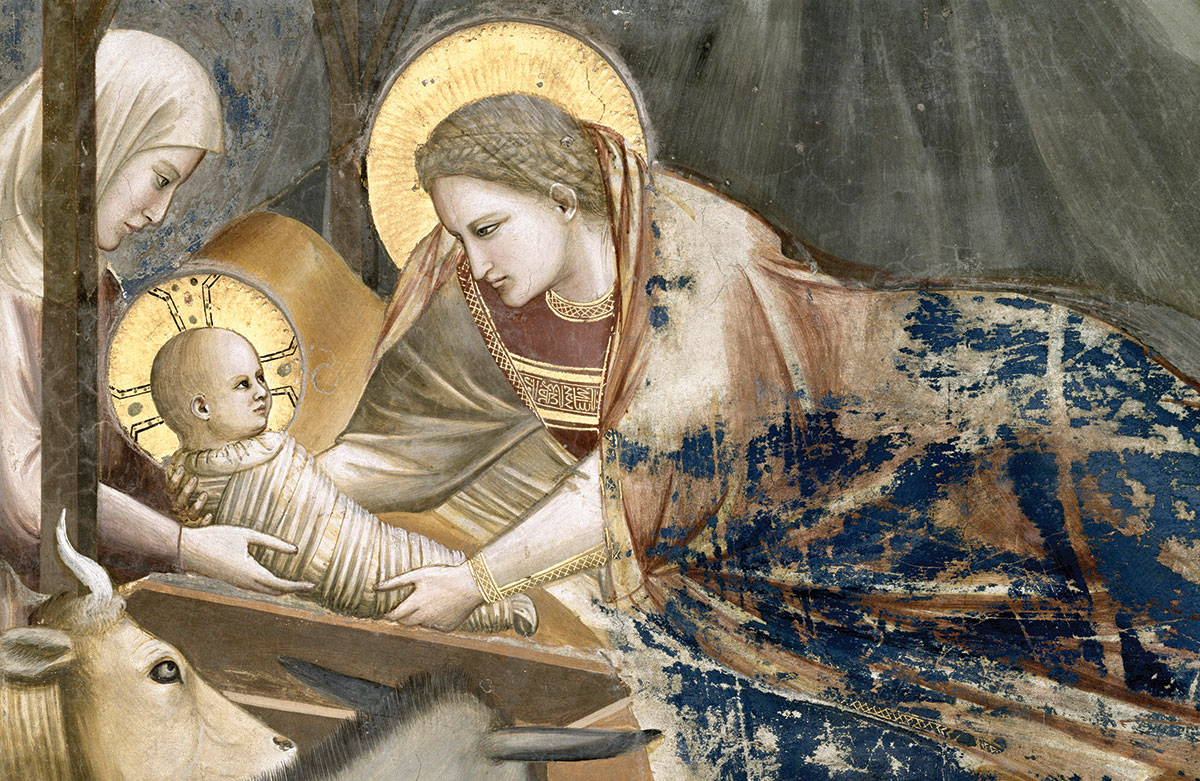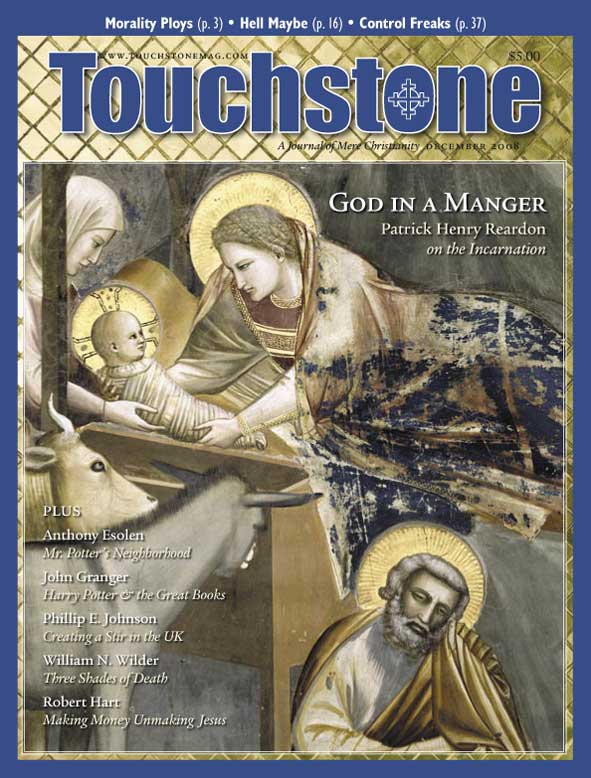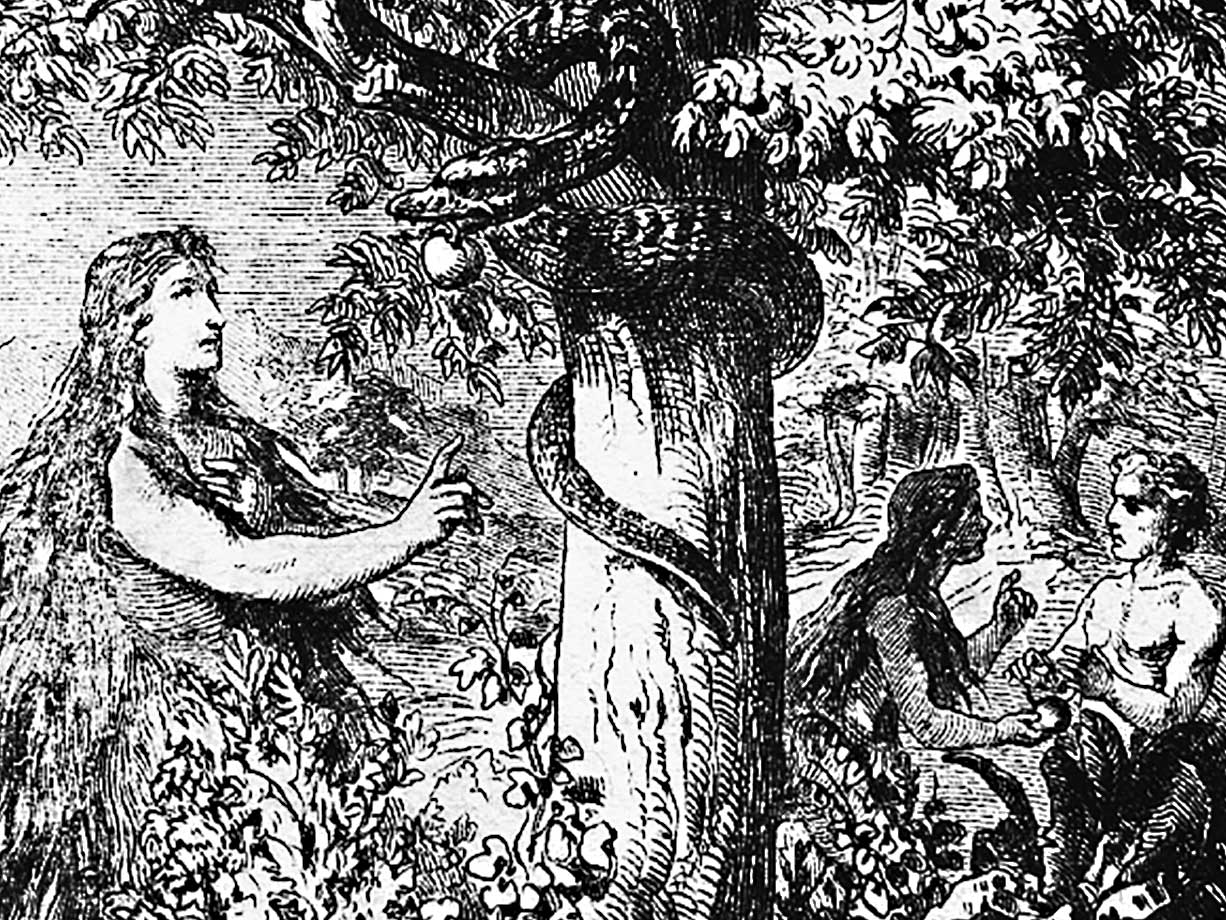Feature
Savior in a Manger
Early Christian Teaching on the Incarnation & Redemption
Advent and the Christmas season form an ideal time, surely, during which to ponder the meaning—especially the soteriological meaning—of the Incarnation. The question, Cur Deus homo—“Why did God become man?”—rises spontaneously to the healthy Christian mind, I believe, and it is a fact that Christians began addressing that question rather early. The Council of Nicaea declared simply that the Incarnation took place “for us men and for our salvation,” a formula adopted without change by the Council of Chalcedon somewhat more than a century later. That is to say, it is a dogma of those councils that God’s intent in the Incarnation was soteriological: It had to do with man’s salvation.
Nonetheless, the history of theology has witnessed a certain diversity in the ways this soteriological intent of the Incarnation was expressed. More specific answers to the question “Why did God become man?” depended in no small measure on the meaning of salvation, and Christians, even from New Testament times, have described salvation itself from fairly different perspectives. God’s redemption of man is a marvelously rich reality—according to the Psalmist, copiosa apud Eum redemptio—so we should expect a variety of conceptual approaches to it.
In the reflections that follow, I want to consider the soteriological aspect of the Incarnation in our earliest sources, the period long prior to the major divisions of the churches. The selection of these sources, though limited, is not random. I have picked these particular writers, because the Christian Tradition itself has ever recognized them as authentic voices of the original apostolic message. Since this is a study of written sources, I propose to begin with our first literary theologian, St. Paul.
Christ & Adam
Arguably among the earliest themes of Christian soteriology was a contrast between Christ and Adam. The letters of Paul are obviously the literary font of this contrast, chiefly in two places, the earlier being 1 Corinthians 15, and the second Romans 5. These two texts differ, however, in emphasis and application.
In the slightly earlier text, 1 Corinthians 15, Paul’s argument may be called cosmological, because it has to do with the quality of created matter, the “dust” of Genesis 2–3. Paul’s argument in this text is largely centered on Adam’s legacy of death and corruption, to which the apostle contrasts the immortality of the body achieved through the Resurrection of Christ: Adam, he says, was formed of dust (Gen. 2), to which he returned by reason of the Fall (Gen. 3). Nonetheless, Paul goes on, because of Christ’s Resurrection from the dead, this inheritance of corruption from Adam is not the final word about the human prospect.
Although humanity certainly shares in Adam’s corruption, in Christ it is made to share in the incorruptibility of the Resurrection: “The body is sown in corruption, it is raised in incorruption” (1 Cor. 15:42). Thus, “as we have borne the image of the man of dust, we shall also bear the image of the heavenly Man” (15:49). By rising from the dead, in short, Christ conferred immortality on the flesh he assumed in the Incarnation. As will be evident presently, it is impossible to overestimate the importance of this argument in the Patristic answer to the question, Cur Deus homo?
In the second and later text, Romans 5, Paul returns to the contrast between Adam and Christ, but now with a different emphasis and application. He here develops the same theme from a historical rather than a cosmological perspective. That is to say, his interest in Romans is man’s history (life in time) rather than his physical composition (life in matter).
Whereas in Adam, Paul argues, “sin entered the world, and death through sin,” through the obedience of Christ “many will be made righteous” (Rom. 5:12,19). In short, “if by the one man’s offense many died, much more the grace of God and the gift by the grace of the one Man, Jesus Christ, abounded to many” (5:15).
Each of these two Pauline contrasts between Adam and Christ serves the general concern of the specific epistle in which it appears. In 1 Corinthians, it is the Paschal Mystery (“Christ, our Passover, was sacrificed for us,” says 1 Corinthians 5:7), whereas in Romans it is justification. The Romans text, which treats of the obedience of Christ, reflects the theology of Good Friday. First Corinthians, which is concerned with the Resurrection, pertains to the theology of Easter Sunday. Both themes, as we shall see, are developed in the early church fathers.
An Earlier Insight
Although St. Paul was the first Christian writer to develop the theological contrast between Christ and Adam, he was certainly not the first Christian to think of it. We already find that contrast in an ancient hymn verse cited in the Epistle to the Philippians:
Have this mind among yourselves, which is yours in Christ Jesus, who, though he was in the form of God, did not count equality with God a thing to be grasped, but emptied himself, taking the form of a servant, being born in the likeness of men. And being found in human form he humbled himself and became obedient unto death, even death on a cross. Therefore God has highly exalted him and bestowed on him the name which is above every name, that at the name of Jesus every knee should bow, in heaven and on earth and under the earth, and every tongue confess that Jesus Christ is Lord, to the glory of God the Father. (Phil. 2:5–11)
Two points may be made about this passage, I believe, with respect to the theme of these reflections.
First, its rich doctrinal character is surprising in a context where we would not necessarily expect it. This context is not doctrinal. It is, rather, a moral exhortation, in which Paul describes how Christians are to be humble and obedient in their regard and behavior toward one another (2:1–4,12–16). Settled in the middle of this context, the Christological passage just quoted has the feel of an insertion. It takes the reader in a specifically doctrinal direction. It appears that Paul, wanting to hold up the example of the obedience of Christ, reminds them of a text that he expects his readers to recognize right away. Familiar texts like this are frequently taken from well-known hymns, and a close reading of the passage suggests a strophic structure.
Second, at least part of the content of this hymnic insertion clearly relies on a contrast between Christ and Adam. Adam, we recall, was disobedient in trying to become like God. This is implied in what the serpent told Eve with respect to the forbidden fruit: “For God knows that in the day you eat of it your eyes will be opened, and you will be like God” (Gen. 3:5). That is to say, disobedient Adam “regarded equality with God a thing to be grasped” (harpagmon egesato to einai isa Theo).
God’s Son, in contrast, being “in the form of God” (en morphe Theou), was already “equal to God” (isa Theo). He had no need to grasp it. Yet he emptied himself and assumed “the form of a servant” (morphen doulou), becoming obedient to death on the Cross. This is the model of obedience that Paul holds out to Christians, telling them, “Have this mind (touto phroneite) among yourselves.” That is to say, believers are to abandon the example of Adam and pursue the standard of Christ.
In sum, Paul himself clearly inherited this contrast between Adam and Christ from the theology—apparently the hymnography—of early Christian worship. For this reason, it should be regarded as springing from the most primitive theological insights of Christians. In 1 Corinthians and Romans, Paul himself presents new developments on the same theme, applied to the two disputed questions he had in mind to address, the Resurrection (1 Corinthians 15) and justification (Romans 5).
Man’s New Headship
These two points of contrast elaborated by Paul would not be possible, however, unless the early Christians had already recognized between Christ and Adam some evidence of analogy that prompted them to compare the two. It is not difficult to discern those earlier points of comparison.
Thus, Jesus, like Adam, was tempted. An early story transmitted in Mark, precisely in the context of Jesus’ temptations, preserved the tradition of our Lord’s companionship with the animals (Mark 1:13). This story, of course, puts the reader in mind of Adam in the midst of the animals in Genesis 2, prior to the Fall in the following chapter. Jesus’ victory over his temptations by Satan thus inaugurates a new state of Paradise, as it were, in which the friendly relations of men and the beasts, disrupted since the Fall, are restored. That is to say, Jesus is portrayed as a new Adam.
In Luke the Adam/Christ analogy is subtler, and we discern it in the way the Lord’s genealogy is arranged. To detect this, we may observe two differences between the genealogies in Matthew and Luke.
First, unlike Matthew, Luke traces the Lord’s lineage all the way back to Adam, not just to Abraham. This format emphasizes Jesus’ relationship to whole human race, and not just the Jews. For this reason, in citing the famous Isaian text that begins the ministry of John the Baptist in all the Synoptic Gospels (Matt. 3:3; Mark 1:2–3; Luke 3:4–6), it is entirely appropriate that Luke alone quotes the words, “and all flesh shall see the salvation of God.”
Second, whereas Matthew’s genealogy of Jesus comes at the beginning of his Gospel, Luke places it after the Lord’s baptism and right before the account of his temptation. This arrangement prompts the reader to make the comparison that Luke has in mind to infer, the temptations of Jesus and the temptations of Adam.
More significantly, perhaps, St. Paul, even as he contrasted Adam and Christ, called Adam “a type of him who was to come” and went on immediately to speak of “the one Man Jesus Christ” (Rom. 5:14–15). That is to say, the perceived analogy between Adam and Christ was the basis for his contrasting them.
They are both “Adam,” wrote Paul: “‘The first man Adam became a living being.’ The last Adam became a life-giving spirit” (1 Cor. 15:45). And he went on, “The first man was of the earth, made of dust; the second Man is the Lord from heaven” (15:47). What Adam and Christ share is the designation “man,” anthropos, the Greek equivalent of the Hebrew ’adam. This is the foundation of the “type” that Paul perceived in Adam with respect to Christ.
Christ, according to the apostle, is not only the “second Man,” he is also “the last Adam”— ho eschatos Adam, “the final Adam,” the Adam by whom the world’s last age comes to be.
This eschatology pertains to the Incarnation, of which Paul had written earlier: “when the fullness of the time had come, God sent forth his Son, born of a woman” (Gal. 4:4). The “fullness of time” is the world’s last age. Although all of biblical history was a period of preparation for the Son’s assumption of our flesh, that assumption radically altered the direction and destiny of history. Old Adam was replaced.
He was replaced precisely as head of the human race. Moving from history to cosmology, Paul later adopted another metaphor to express this replacement—Christ as “head.” For Paul, this expression meant more than Christ’s headship over the Church. It included also his headship over all the powers of Creation (Col. 2:10). Thus, Paul spoke of God’s plan to “re-head all things in Christ”— anakephalaiosasthai ta panta en Christo (Eph. 1:10). This rather long verb, which means to sum up or concentrate under one head, is Paul’s way to describe Christ’s relationship to Creation as a whole. Adam’s cosmic dominion (Gen. 1:28) was replaced and enhanced in Christ (Col. 2:9–10).
In the second century, Irenaeus, whose understanding of this subject came directly from the Asian churches to whom Paul wrote this theme, further elaborated the apostle’s understanding of the Christ/Adam analogy and its particular reference to the “re-heading” of Creation. Before considering Irenaeus, however, there is one other New Testament source that needs investigation.
The Body—Sacrificed & Risen
The soteriological intent of the Incarnation was expressed very early in the Epistle to the Hebrews. According to this source, the Incarnation provided God’s Son with the means of suffering and dying in obedience to his Father. Commenting on Psalm 40 (39), the author wrote with respect to the Incarnation,
Therefore, when he came into the world, he said:
“Sacrifice and offering you did not desire,
But a body you have prepared for me.
In burnt offerings and sacrifices for sin
You had no pleasure.
Then I said, ‘Behold, I have come—in the volume of the book it is written of me—
To do your will, O God.’”(Heb. 10:5–7)
That is to say, the obedience of Christ was to fulfill and replace the various sacrifices of the Mosaic Law, and for this task the Son obviously required a body.
Moreover, the Son needed this body in order to suffer and die for the human race. Thus, commenting on Psalm 8, this author described in what way the Son became man for our salvation. “We see Jesus,” he wrote, “who was made a little lower than the angels for the suffering of death, crowned with glory and honor, that he, by the grace of God, might taste death for everyone” (2:9).
In order to “taste death” in obedience to the Father, then, the Son assumed our flesh. In order to die as an act of sacrifice, he had to share the mortality of our flesh. Hebrews goes on to say, “Inasmuch then as the children have partaken of flesh and blood, he himself likewise shared in the same, that through death he might destroy him who had the power of death, that is, the devil, and release those who through fear of death were all their lifetime subject to bondage” (2:14–15).
In sum, two aspects of the soteriology of the Incarnation are especially to be observed in treatment of the theme in Hebrews. First, God’s Son assumed our flesh in order obediently to die in that flesh. Second, his death in the flesh meant the destruction of the devil, “who had the power of death.” According to Hebrews, then, God’s Son took flesh in order to die, and he died in order to overcome death and the devil. This line of theological reflection—Incarnation, death, victory—continued throughout Christian history, combining with other biblical themes along the way.
Headship & Resurrection
In the following century, Irenaeus, the second bishop of Lyons, followed the same theological line as the author of Hebrews, but he adorned it by introducing the Pauline contrast between Christ and Adam. According to Irenaeus, the Word’s assumption of the flesh was required for our salvation, because Adam’s sin had been committed in the flesh. Sin in the flesh required salvation in the flesh. He explained, “So the Word was made flesh in order that sin, destroyed by means of that same flesh through which it had gained mastery and taken hold and lorded it, should no longer be in us,” and “that so he might join battle on behalf of our forefathers and vanquish through Adam what had stricken us through Adam” (Proof of the Apostolic Preaching 31).
As I noted, Irenaeus here is clearly the heir to St. Paul, who contrasted Christ and Adam in terms of “disobedience unto death” and “obedience unto life” (Rom. 5:12–19)
In his treatment of salvation, however, Irenaeus stresses the Resurrection much more explicitly than is obvious in the Epistle to the Hebrews, and this, in turn, colors his approach to the Incarnation. Thus, he writes of “our Lord’s birth, which the Word of God underwent for our sake, to be made flesh, that he might reveal the resurrection of the flesh and take the lead of all in heaven.” In this way, explains Irenaeus, Christ becomes “the first-born of the dead, the head and source of the life unto God” (op.cit., 39).
Irenaeus, not neglecting the biblical theme of “obedience in the flesh,” sets himself to provide a more ample answer to the question “Why Incarnation?” His larger answer to this question, an answer that includes the resurrection from the dead, colors his soteriology with a dominant concern for the total transformation of humanity, and all of creation, in Christ. In tying the soteriological intent of the Incarnation to the Lord’s Resurrection from the dead, Irenaeus advances an important doctrinal perspective. We may contrast this perspective with the soteriology of some later Christians, who concentrated entirely on the Lord’s atoning death as the means of our redemption, with scarcely any attention to the soteriological significance of the Incarnation or the Resurrection.
Man’s New Life
We began these considerations with the Council of Nicaea, which declared that the Word became flesh “for us men and for our salvation.” We come now to the historical link between the tradition of Irenaeus and that council: Athanasius of Alexandria, the first man to write a treatise devoted entirely to the theme: “Why Incarnation?”
In addressing that question, Athanasius largely follows the lines of response already elaborated in the Epistle to the Hebrews and in Irenaeus—namely, the Incarnation was required for man’s reconciliation with God. Man’s repentance from sin, Athanasius contended, would not have been sufficient to restore him to friendship with God. Indeed, to imagine otherwise would be to suppose an inadequate and unbiblical view of sin.
Sin is not a merely moral offense, after all, an injury readily cured by simple repentance. Still less is it just a forensic declaration of guilt that could be reversed by a contrary declaration of reprieve. Nor is sin just a spiritual state that could be altered by some kind of spiritual adjustment. And certainly sin is not the sort of affront that can be remedied by a sincere apology.
According to Holy Scripture, sin is bondage to death and corruption. Death and corruption are not punishments imposed on sin from without. They are internal to sin itself, the very “em bodiment” of sin. Man was warned, “in the day that you eat of it you will die!” (Gen. 2:17). Thus, the Apostle Paul declared that “sin reigned in death” (ebasilevsen he hamartia en to thanato—Rom. 5:21). To deal with sin, it was necessary to deal with death. For this reason, Athanasius argued, the power of sin, which is the corruption of death, had to be defeated in the flesh.
This necessity of the Word’s enfleshment pertained to what Athanasius called “the divine reasonableness” (to evlogon to pros ton Theon— On the Incarnation 7). Whereas many later theologians thought of Redemption in terms of the divine honor or divine justice, Athanasius thought of it in terms of the divine “reasonableness” or evlogon—the sustained propriety, coherence, consistency, and proportion that distinguishes all of God’s dealings with men.
The death of Christ in the flesh, in the eyes of Athanasius, was directed, then, not at God’s offended justice, but at man’s bondage to corruption. God had not told Adam, “in the day that you eat of it, I will get terribly upset,” but “in the day that you eat of it, you will die.” Sin entered into man, not God. For sin to be defeated, something in man had to change.
Now, since man had fallen in the flesh, reasoned Athanasius, it was reasonable, symmetric, appropriate, and proportionate—in short, evlogon—that man be restored through the flesh. “For this purpose, then, the incorporeal and incorruptible and immaterial Word of God entered our world” (ibid. 8).
Thus, Athanasius explained, it pertained to the Word, “and to him alone, to bring again the corruptible to incorruption and to guard for the Father his reasonableness in all things (to hyper panton evlogon). Being the Word of the Father and above all, he alone was consequently able and qualified to recreate (anaktisai) all, to suffer for all (hyper panton pathein), and to represent all to the Father” (ibid. 7).
Following the line of argument that we find in Hebrews 2, Athanasius reasoned thus: “The Word understood that corruption could not be destroyed except through death. Yet, as God’s Word and Son, he was immortal and could in no wise die. For this reason he took on a body capable of dying.” By sharing the flesh of mortal human beings, Athanasius went on, God’s Word offered himself on their behalf: “By surrendering to death the body that he had taken, as an offering and sacrifice free from defilement—by this proportionate offering—he obliterated death for all those who shared it with him” (ibid. 9).
In order to overcome this corruption of sin, however, it was required, not only that God’s Word should die in the flesh, but also that he should rise again in the flesh. Only in the Resurrection was corruption abolished. Indeed, God’s Word assumed the body in order to be raised in the body:
It was the Lord’s chief concern to bring about (poiein) the resurrection of the body. With respect to death this was the trophy for public display, to be everyone’s guarantee that he had overcome corruption, and that their own bodies would in due course be incorrupt. It was in pledge thereto and as a declaration of everyone’s future resurrection that he preserved his own body incorrupt. (ibid. 22)
For this reason, wrote Athanasius, Christ died in order to rise: “death had to precede resurrection, for there could be no resurrection without it” (ibid. 23). “He descended in a body, and he rose again, because he was God in a body. . . . Death pertains to man. Therefore the Word, as God, became flesh in order that, being put to death in the flesh, he might give life to all men by the power that is proper to him” (Against the Arians 1.44).
In Athanasius, then, whose Christology became the standard of orthodoxy in the fourth century, the Incarnation pertained essentially to the mystery of man’s redemption. He insisted that the Word’s assumption of our flesh was the condition of his death and Resurrection, because he perceived the “fleshly” nature of that redemption.
The Middle Man
Although it was only at Chalcedon, in 451, that church dogma defined that Jesus Christ is one person “confessed in two natures,” versions of that formula had already become standard in Christology, especially in the West. Decades prior to Chalcedon, Augustine of Hippo had spoken of Jesus as “one person in each nature” (una persona in utraque natura— Sermons 294.9) and had affirmed, “he who is God is the very one who is man, not by the confusion of nature but by unity of person” (Sermons 186.1; cf. Enchiridion 10.35; De Trinitate 1.7.14; 13.17.22). Jesus Christ, said Augustine, is “all God and all man” (totus Deus et totus homo— Sermons 293.7; cf. 130.3; Tractatus in Joannem 19.15; 47.12). Summing up his Christology near the end of his life, Augustine wrote that God’s Son assumed our humanity “in an incomparable union in such wise that he who assumed and that which was assumed is one person in the heart of the Trinity” (de Predestinatione Sanctorum 24.67).
If Augustine was a precursor to Chalcedon, however, he was also an heir of Nicaea. After spending his youth imagining Jesus “only as a man of excellent wisdom that no one could equal,” Augustine at last learned the correct Nicene Christology during the catechumenate that preceded his baptism in 387 (Confessions 7.19.25). We also know that he had begun to read Athanasius at about that time (8.6.14–15; 10.23.50).
Like Irenaeus, Athanasius, and the New Testament sources, Augustine approached the mystery of the Incarnation under the perspective of soteriology, specifically man’s deliverance from mortality and his liberation to immortality—his movement from death to life.
We see this especially in his analysis of the mediation of Christ. When Augustine treats of Jesus as our Mediator, he does so in terms of man’s passage from death to life. That is to say, God’s Son is the “distributed middle,” the medium between corruption and immortality. Christ assumed the first of these from us, wrote Augustine, in order to confer upon us the second (de Consensu Evangelistarum 1.35.53).
Augustine returns to this theme repeatedly: God’s Son took away our mortality through his death (Enchiridion 33; Enarrationes in Psalmos 103.8) and conferred his immortality upon us through his Resurrection (The City of God 9.15; 10.24). “In his passion,” Christ “became the sacrifice, and in his Resurrection he restored (innovavit) what had been killed and offered it as a first fruit to God” (Enarrationes in Psalmos 129.3.7). In the Incarnation, that is to say, he was born in our flesh in order to die and rise in our flesh. “We need a Mediator,” he wrote, “who, united to us here below by the mortality of his body, should at the same time be able to give us truly divine help in cleansing and liberating us by means of the immortal righteousness of his spirit, whereby he remained heavenly even while here on earth” (The City of God 9.17).
For Augustine, then, the redemptive mediation of Christ was enacted, not in the single event of the Cross, but in the full Christian mystery, from the first moment of the Incarnation until the final glorification of the risen Lord (Against Cresconius the Donatist 4.54,64).
Augustine’s perspective on soteriology was historical. For him, the mediation between God and man was effected in all those historical events—Christ’s birth, his crucifixion, his death, and his Resurrection—by which he, in our flesh, took away our sinful mortality and conferred on us his godly immortality (Tractatus in Joannem 23.15). Indeed, Augustine viewed all of human history under the perspective of those things that the incarnate Word accomplished in the flesh (The City of God 18.46).
Augustine’s emphasis, however, was placed firmly on the Resurrection. Because he thought of salvation not simply as the removal of guilt, but also as the attainment of immortality, Augustine believed that it was ultimately with a view to his rising again that God’s Son assumed our flesh. The “Christian doctrine and religion,” Augustine wrote, “was defined in the Resurrection of Christ” (18.54). Hence, he called Christ’s Resurrection “the salvation of Christians”— salus Christianorum—apparently in the sense that being raised is essentially what Christians mean by being saved (Sermons 361.3). The risen Christ, he wrote, is the cause and the exemplar of our own final rising (Letters 102.1.5).
Christmas & the Coming Spring
In all of these ancient Christian sources, we observe an obvious reluctance to isolate the Incarnation from the other events of the Word made flesh, wherein our very redemption was accomplished. Unless I misjudge the intent—or misinterpret the message—of our traditional Christmas hymns and carols, this understanding of the Incarnation has not been lost on modern Christians. They think of that mystery in terms of man’s redemption. Christmas is the birth of the Savior.
I am not persuaded, however, that modern Christians always think about man’s redemption through the lens of the Incarnation. Indeed, I am familiar with numerous treatises on salvation that never mention the soteriological value of that event. For many Christians, it appears to me, concern with man’s salvation has become so centered on Calvary that Bethlehem tends to be shoved rather much to the side. For the authors we have just studied, nonetheless, this was clearly not the case, and I confess that, in this brief examination of the soteriology of the early Church, I had in mind its corrective value for contemporary theology.
In short, Christmas is the first step in our redemption. It prepares the Christian mind and heart for the other salvific events celebrated during the spring—the death and Resurrection of our Lord. As the Christian calendar of the West has always supposed, Advent and the birth of Christ form an appropriate beginning of the year of grace. •
Patrick Henry Reardon is pastor emeritus of All Saints Antiochian Orthodox Church in Chicago, Illinois, and the author of numerous books, including, most recently, Out of Step with God: Orthodox Christian Reflections on the Book of Numbers (Ancient Faith Publishing, 2019).
subscription options
Order
Print/Online Subscription

Get six issues (one year) of Touchstone PLUS full online access including pdf downloads for only $39.95. That's only $3.34 per month!
Order
Online Only
Subscription

Get a one-year full-access subscription to the Touchstone online archives for only $19.95. That's only $1.66 per month!
bulk subscriptions
Order Touchstone subscriptions in bulk and save $10 per sub! Each subscription includes 6 issues of Touchstone plus full online access to touchstonemag.com—including archives, videos, and pdf downloads of recent issues for only $29.95 each! Great for churches or study groups.
Transactions will be processed on a secure server.
more on Christmas from the online archives
more from the online archives

28.2—March/April 2015
Man, Woman & the Mystery of Christ
An Evangelical Protestant Perspective by Russell D. Moore
calling all readers
Please Donate
"There are magazines worth reading but few worth saving . . . Touchstone is just such a magazine."
—Alice von Hildebrand
"Here we do not concede one square millimeter of territory to falsehood, folly, contemporary sentimentality, or fashion. We speak the truth, and let God be our judge. . . . Touchstone is the one committedly Christian conservative journal."
—Anthony Esolen, Touchstone senior editor












